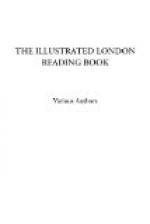FREMONT’S Travels.
* * * * *
THE GROUSE.
[Illustration: Letter W.]
We have but few European birds presenting more points of interest in their history than the Grouse, a species peculiar to the northern and temperate latitudes of the globe. Dense pine forests are the abode of some; others frequent the wild tracts of heath-clad moorland, while the patches of vegetation scattered among the rocky peaks of the mountains, afford a congenial residence to others. Patient of cold, and protected during the intense severities of winter by their thick plumage, they give animation to the frozen solitude long after all other birds have retired from the desolate scenery. Their food consists of the tender shoots of pines, the seeds of plants, the berries of the arbutus and bilberry, the buds of the birch and alder, the buds of the heather, leaves, and grain. The nest is very simply constructed, consisting of dried grasses placed upon the ground and sheltered among the herbage.
Two species of this bird, called forest grouse, are indigenous in England: one is the black grouse, common in the pine woods of Scotland and of the northern part of England, and elsewhere; the other is the capercailzie or cock of the woods. Formerly, in Ireland, and still more recently in Scotland, this noble bird, the most magnificent of the whole of the grouse tribe, was abundant in the larger woods; but it gradually disappeared, from the indiscriminate slaughter to which it was subject. Selby informs us that the last individual of this species in Scotland was killed about forty years ago, near Inverness. It still abounds in the pine forests of Sweden and Norway, and an attempt has been made by the Marquis of Breadalbane to re-introduce it into Scotland.
The red grouse, or moor grouse, is found in Scotland; and it is somewhat singular that this beautiful bird should not be known on the Continent, abundant as it is on the moorlands of Scotland, England, and Ireland. The breeding season of the red grouse is very early in spring, and the female deposits her eggs, eight or ten in number, in a high tuft of heather. The eggs are peculiarly beautiful, of a rich brown colour, spotted with black, and both herself and her mate attend the young with great assiduity. The brood continue in company during the winter, and often




